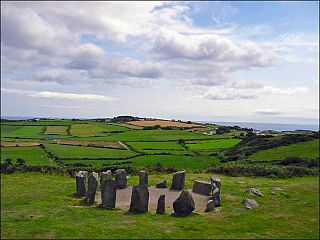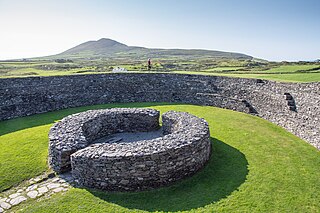
A stone circle is a ring of standing stones. Most are found in Northwestern Europe—especially in Britain, Ireland and Brittany—and typically date from the Late Neolithic and Early Bronze Age, with most being built from 3000 BC. The best known examples include those at the henge monument at Avebury, the Rollright Stones, and elements within the ring of standing stones at Stonehenge. There are scattered examples from other parts of Europe. Later, during the Iron Age, stone circles were built in southern Scandinavia.

Knocknakilla is the site of a megalithic complex situated between Macroom and Millstreet, in County Cork, Ireland. It is set in blanket peatland on the north-west upper slopes of Musherabeg mountain and is thought to be 3500 years old.
Bohonagh is an axial stone circle located 2.4 km east of Rosscarbery, County Cork, Ireland. The circle is thought to date from the Bronze Age. A boulder burial is sited nearby.

Carrigagulla is a megalithic complex 2.9 km north-east of Ballinagree, County Cork, Ireland.

Drombeg stone circle, is a small axial stone circle located 2.4 km (1.5 mi) east of Glandore, County Cork, Ireland.

The Uragh Stone Circle is an axial five-stone circle located near Gleninchaquin Park, County Kerry, Ireland. The Bronze Age site includes a multiple stone circle and some boulder burials.
Ballintaggart Ogham Stones is a collection of ogham stones forming a National Monument located in County Kerry, Ireland.

Altar Wedge Tomb is a wedge-shaped gallery grave and National Monument located outside the village of Schull, in County Cork, Ireland.
Lissacresig is a ringfort (rath) and National Monument (#571) located in County Cork, Ireland.
The Coolcoulaghta Standing Stones are a pair of standing stones forming a stone row and National Monument located in County Cork, Ireland.
Breeny More Stone Circle is an axial stone circle and National Monument located in County Cork, Ireland.
Carrigaphooca Stone Circle is a stone circle and National Monument located in County Cork, Ireland.

Cahergall is a stone ringfort (cashel) and National Monument located in County Kerry, Ireland.
Maughanasilly Stone Row is a stone row and National Monument located in County Cork, Ireland.

Labbamolaga Church is a medieval church and National Monument located in County Cork, Ireland.

An axial stone circle is a megalithic ring of stones of a particular design found in County Cork and County Kerry in southwest Ireland. Archaeologists have found it convenient to consider the axial five-stone circle and axial multiple-stone circle separately. The circle has an approximate axis of symmetry aligned in a generally northeast–southwest direction. The stone at the southwest side of the circle, rather than being an upright orthostat like all the rest, is a slab lying horizontally with its long thin edge along the circumference of the ring. Because it marks the axis of the circle it is called the axial stone.

Kealkill stone circle is a bronze age axial five-stone circle located just outside the village of Kealkill, County Cork in southwest Ireland. When it was excavated in 1938 it was thought the crucial axial stone indicated an alignment to the north, contrary to the general alignment of such stone circles to the southwest. However, later archaeologists have thought it is the comparatively insignificant stone to the southwest that is the axial stone. There are two associated standing stones nearby, one of which had fallen and was re-erected in 1938.










